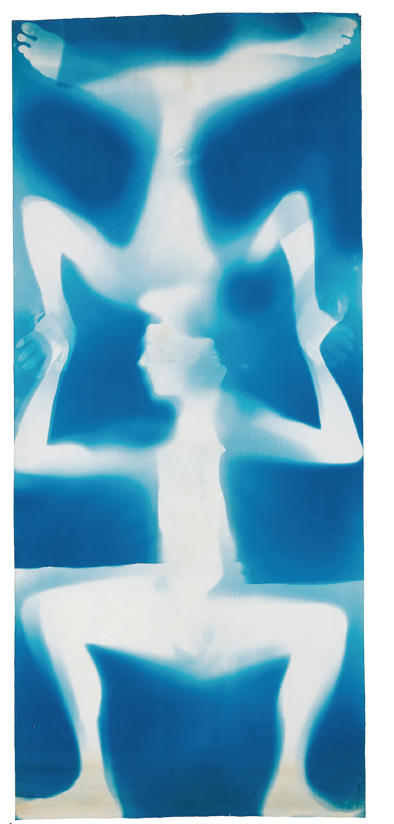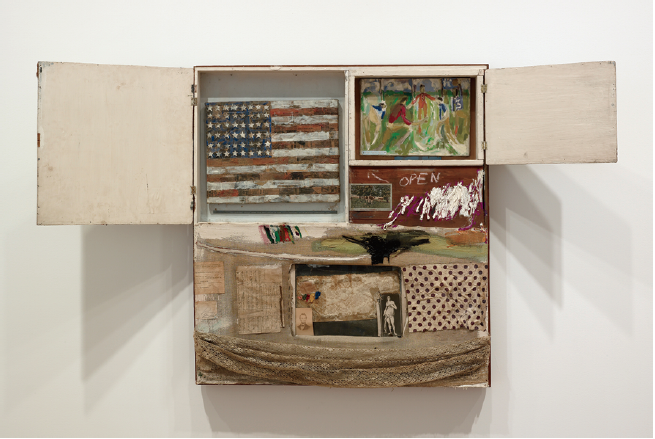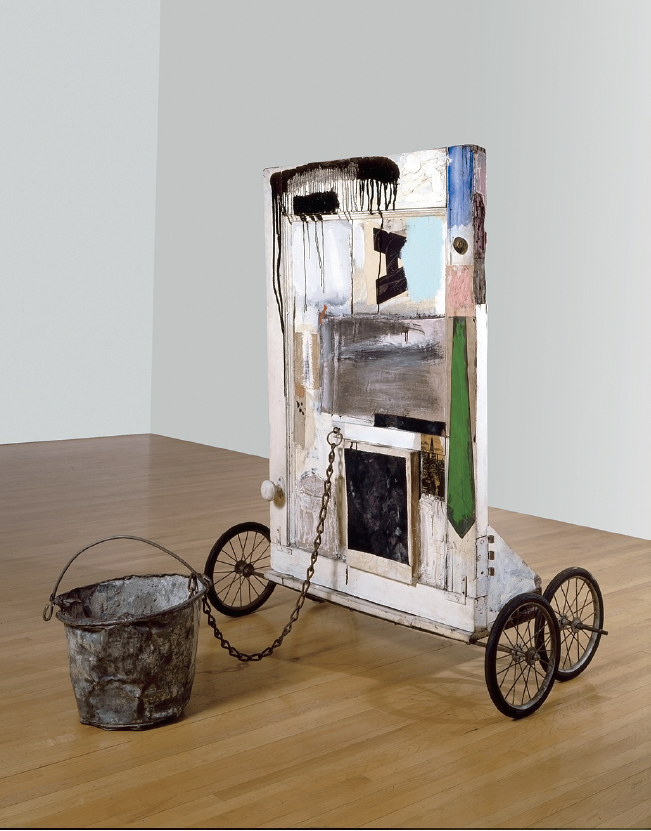Robert Rauschenberg
To be a friend of Robert Rauschenberg’s was to be within one of the most charmed circles of the 20th century. Tall, handsome and, by all accounts, charming, Rauschenberg had a gravitational pull that drew others to him, catching them in creative and intimate dynamics that were in themselves richly generative, mutually sustaining and breathtakingly original. The massive retrospective “Rauschenberg and Friends” at the Museum of Modern Art (MoMA)—following its initial run at the Tate Modern in London—seeks to highlight not only the dazzling scope of Rauschenberg’s artistic output, but also his collaborative generosity and legacy.
The exhibition is at its most successful when it makes specific connections between Rauschenberg’s protean artistic practice and the diverse intimate relationships that populated his career. Organized both temporally and geographically around particular places such as Black Mountain College, his Fulton and Pearl Street studios in New York City, and ultimately his home and studio on Captiva Island, Florida, Rauschenberg’s enormous output is dialogically presented beside that of his mentors, friends and lovers such as Susan Weil, Cy Twombly, Jasper Johns, John Cage, Merce Cunningham and Andy Warhol. This situational pairing is successful not only in terms of highlighting the collaborative and inclusive aspects of Rauschenberg’s art, but also in situating work that emerged out of creative proximity.

Robert Rauschenberg and Susan Weil, Untitled (Double Rauschenberg), c. 1950, exposed blueprint paper, 6 feet, 10.5 inches x 36.25 inches. Cy Twombly Foundation. © 2017 Robert Rauschenberg Foundation.
From the large and startlingly lovely Blueprints, 1941–1951, made with painter Susan Weil, who taught Rauschenberg the solar photographic print technique, to the Automobile Tire Print, 1953, created with composer John Cage from an impression of the tire of Cage’s vintage Model A Ford, the exhibit reveals how foundational and formative relationships were to Rauschenberg and to his conceptual aesthetic process. Not only did Rauschenberg make and exhibit art with and beside his friends and lovers, his work often incorporated their art into his own, fundamentally blurring the boundaries of the modern autonomous creative subject. Indeed, the placement of small paintings by Jasper Johns (his then lover) and Weil (his ex-wife) into his work Short Circuit, 1955, or the inclusion of drawings by another lover, Cy Twombly, in combines such as Bed, 1955, and Rebus, 1955, speaks to the dense, complicated, yet conceptually rich creative particularity within which these works emerged. What “Rauschenberg and Friends” does achieve is to draw a direct parallel between work such as the combine paintings and the shifting constellation of lovers, friends and collaborators who shaped Rauschenberg’s practice as well as his everyday life. Thus, his “private” world was as much a site for creative interlocutors and conceptual inspiration as were the found materials, objects and referential images that he so skilfully and consistently deployed in his art.

Robert Rauschenberg, Short Circuit, 1955, oil, fabric, notebook paper, postcard, printed reproductions, concert program, and autograph on canvas, wood supports and cabinets with paintings by Susan Weil and Elaine Sturtevant. The Art Institute of Chicago. © 2017 Robert Rauschenberg Foundation.
It’s clear Rauschenberg had a particular genius for engaging with, and distinguishing himself from, what went before. His famous erasure of a Willem de Kooning drawing in 1953 came at the very moment that abstract expressionism was not only at its critical ascendency but was also becoming the public visual language of Cold War liberal internationalism. That Rauschenberg would have the gumption to ask this of the older and more established de Kooning, whom he had first met as a student at Black Mountain College, illustrates not only his conceptual confidence but also his commitment to the legacy of Dada and Marcel Duchamp. That he convinced de Kooning that giving him the drawing to erase would not be an act of destruction, but rather one of creation, was key to the collaboration.
One of the delights of the exhibition is seeing some of Rauschenberg’s lesser-known works, including a variety of playful and absurd mechanical contraptions, as well as videos of his performance art, especially one of a remarkably adept Rauschenberg on roller skates. During his travels to Italy in 1952 with his then lover and fellow artist Cy Twombly, Rauschenberg created a series of works titled Scatolie personali (Personal Boxes). These small-scale assemblages consisted of a variety of wooden boxes—often painted, stained and whitewashed—lined with fabric and paper, and filled with a wide variety of found objects such as needles, animal bones, insect carapaces, dirt, shells, nails, string and other odds and sods. The containers, cabinets and cupboards with lids and doors that could be left open or shuttered— and that order, structure, conceal and segregate elements—fascinated Rauschenberg and are present just as they would be in his large combine paintings of the mid- to late 1950s.
The MoMA show also succeeds in demonstrating Rauschenberg’s foundational interest in performance, dance and photography— as well as the centrality of motion, light and sound. This is illustrated both through his remarkable collaboration with the choreographer and dancer Merce Cunningham— exhibited in a number of videos— but also through his persistent fascination and engagement with technology. Works such as Mud Muse, 1968–1971, an installation of bentonite clay mud that heaves and bubbles due to the release of compressed air triggered by the frequency of ambient music, is a whimsical play of sound, movement and the centrality of seemingly mundane materials. Standing in front of the mesmerizing work, listening to the music and watching the air animate the liquid, the viewer runs the risk of being splashed and literally getting covered with bits of the installation. Here again, Rauschenberg’s conceptual acuity is on full display in an installation that is simultaneously a celebration of industrial materials, engineering and technology, and which nonetheless evokes organic primordial matter and the very creation of life itself.

Gift for Apollo, 1959, oil, fragments of a pair of men’s pants, necktie, wood, fabric, newspaper, printed paper, and printed reproductions on wood with metal bucket, metal chain, doorknob, L-brackets, metal washer, mail, cement, and rubber wheels with metal spokes, 43.75 x 29.5 x 41 inches. The Museum of Contemporary Art, Los Angeles, The Panza Collection.
Yet, even as this exhibition is an amazing display of the diversity and vitality of Rauschenberg’s remarkable contribution to 20th-century contemporary art, there remains hesitancy around the nature of friendship itself. “Rauschenberg and Friends” highlights intimate connections, but it does so without ever really contextualizing how some of these forms of intimacy were considered abject and even criminal. The question of queer sensibility and identity has become increasingly important in the discussion of Rauschenberg—not so much that he had relationships with men, but that his art emerged from a collaborative dynamic that, on the one hand, was part of a gay cultural world and, on the other, routinely referenced sexuality without overtly or explicitly matching itself to the public expression of gay identity. In this sense Rauschenberg was a practitioner of the “open secret” that avoided explicit identification, explanation or commitment. That many of Rauschenberg’s friends, as well as he himself, were “queer” does not mean he should now simply be considered a queer artist, or that his work should be understood as queer. Rather, we might want to think how the ethics of queer conviviality was itself central, even formative, to the aesthetic language, process and sensibilities of conceptual contemporary art in the latter half of the 20th century, and that Rauschenberg was one of its most innovative and brilliant practitioners. ❚
“Rauschenberg and Friends” was exhibited at the Museum of Modern Art, New York, from May 21 to September 17, 2017.
David S Churchill is a queer cultural critic, sometime curator and professor of US history at the University of Manitoba.

